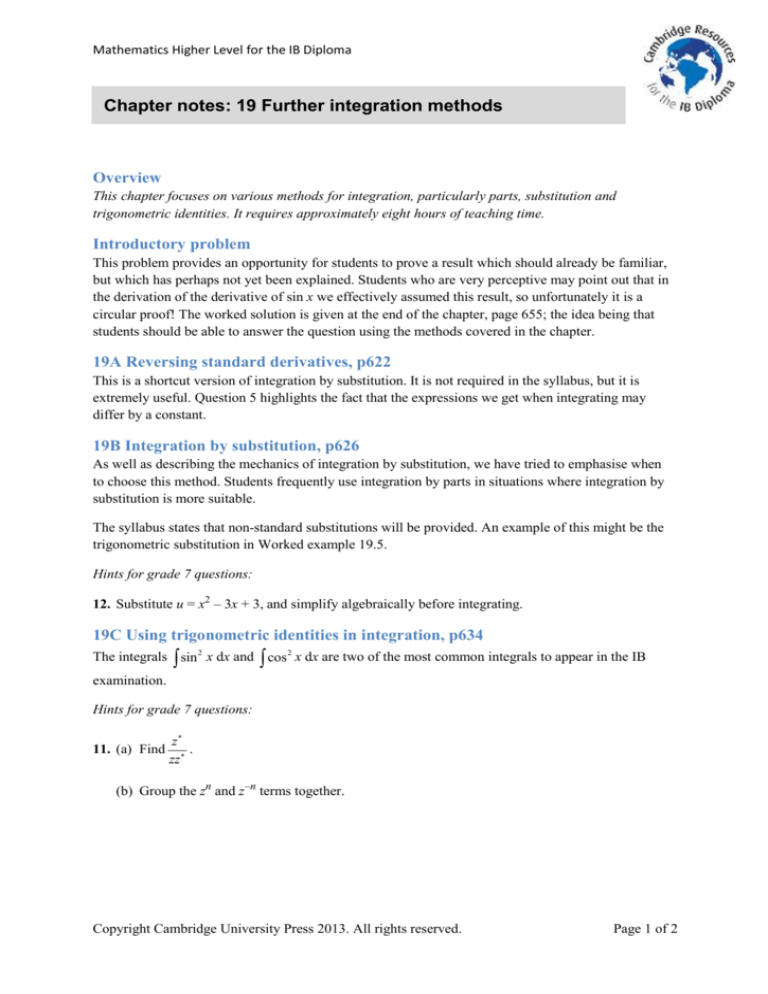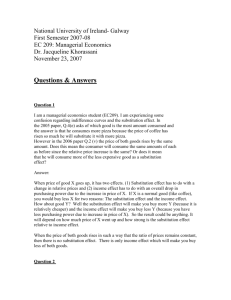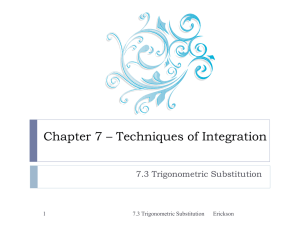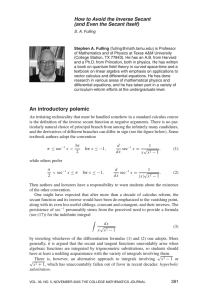
Mathematics Higher Level for the IB Diploma
Chapter notes: 19 Further integration methods
Overview
This chapter focuses on various methods for integration, particularly parts, substitution and
trigonometric identities. It requires approximately eight hours of teaching time.
Introductory problem
This problem provides an opportunity for students to prove a result which should already be familiar,
but which has perhaps not yet been explained. Students who are very perceptive may point out that in
the derivation of the derivative of sin x we effectively assumed this result, so unfortunately it is a
circular proof! The worked solution is given at the end of the chapter, page 655; the idea being that
students should be able to answer the question using the methods covered in the chapter.
19A Reversing standard derivatives, p622
This is a shortcut version of integration by substitution. It is not required in the syllabus, but it is
extremely useful. Question 5 highlights the fact that the expressions we get when integrating may
differ by a constant.
19B Integration by substitution, p626
As well as describing the mechanics of integration by substitution, we have tried to emphasise when
to choose this method. Students frequently use integration by parts in situations where integration by
substitution is more suitable.
The syllabus states that non-standard substitutions will be provided. An example of this might be the
trigonometric substitution in Worked example 19.5.
Hints for grade 7 questions:
12. Substitute u = x2 – 3x + 3, and simplify algebraically before integrating.
19C Using trigonometric identities in integration, p634
The integrals sin 2 x dx and cos 2 x dx are two of the most common integrals to appear in the IB
examination.
Hints for grade 7 questions:
11. (a) Find
z
.
zz
(b) Group the zn and z−n terms together.
Copyright Cambridge University Press 2013. All rights reserved.
Page 1 of 2
Mathematics Higher Level for the IB Diploma
19D Integration using inverse trigonometric functions, p641
The hyperbolic functions mentioned in the ‘Research explorer’ on page642 are sinh x =
e x e x
2
e x e x
. They can be shown to have many similarities to the trigonometric functions.
2
For example, you might like to ask pupils to prove the following:
and cosh x =
d
sinh x = cosh x
dx
sinh 2x = 2 sinh x cosh x
There are however some important differences, for example:
cosh2 x – sinh2 x = 1
Hints for grade 7 questions:
6. Complete the square and then use a substitution.
7. Remember that e2x = (ex)2.
19E Other strategies for integrating quotients, p644
Although partial fractions are not on the syllabus, questions like question 6 could easily appear in the
exam.
Hints for grade 7 questions:
8. (b) Split this into a fraction where the top is the derivative of the bottom, and hence a fraction
with a constant on top.
19F Integration by parts, p649
The three integration by parts ‘tricks’ are presented in Worked examples 19.19 to 19.21. Students
should be familiar with these.
Hints for grade 7 questions:
8. This is another example where choosing
dv
= 1 is useful.
dx
Copyright Cambridge University Press 2013. All rights reserved.
Page 2 of 2










